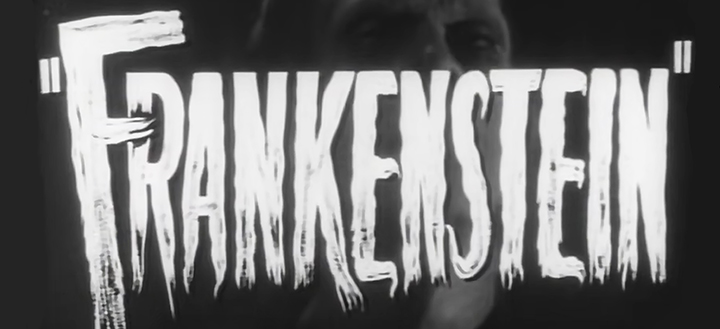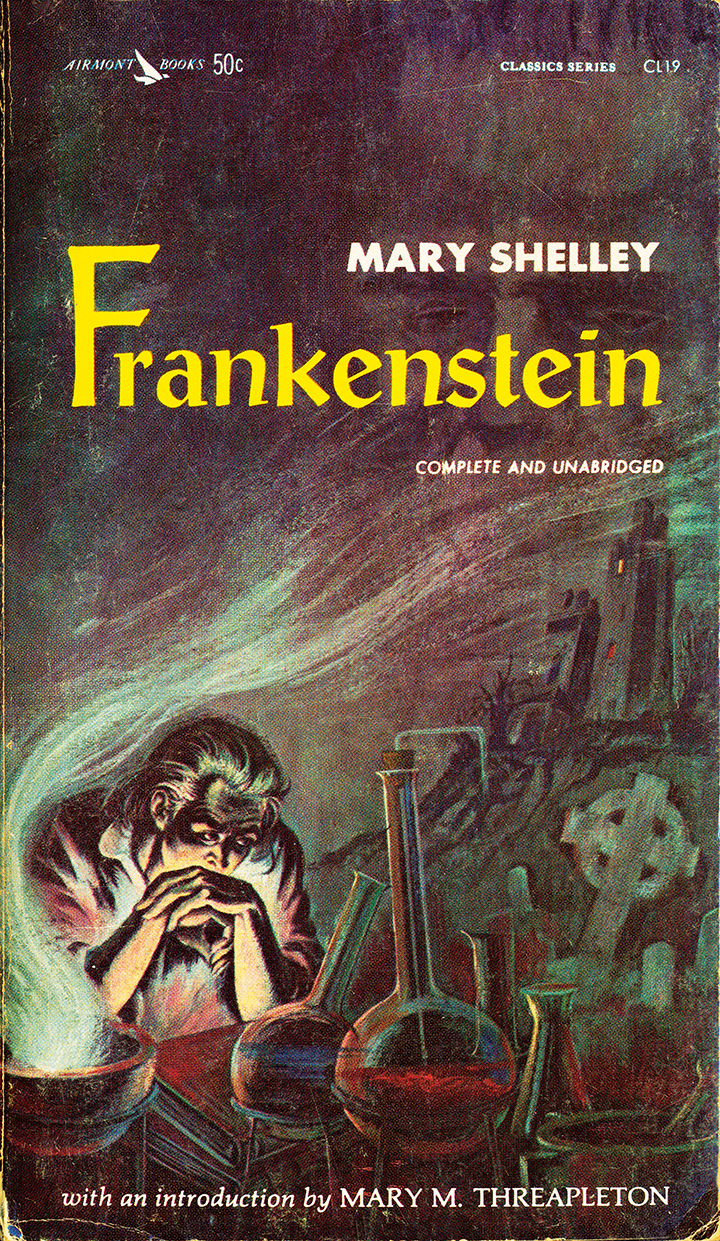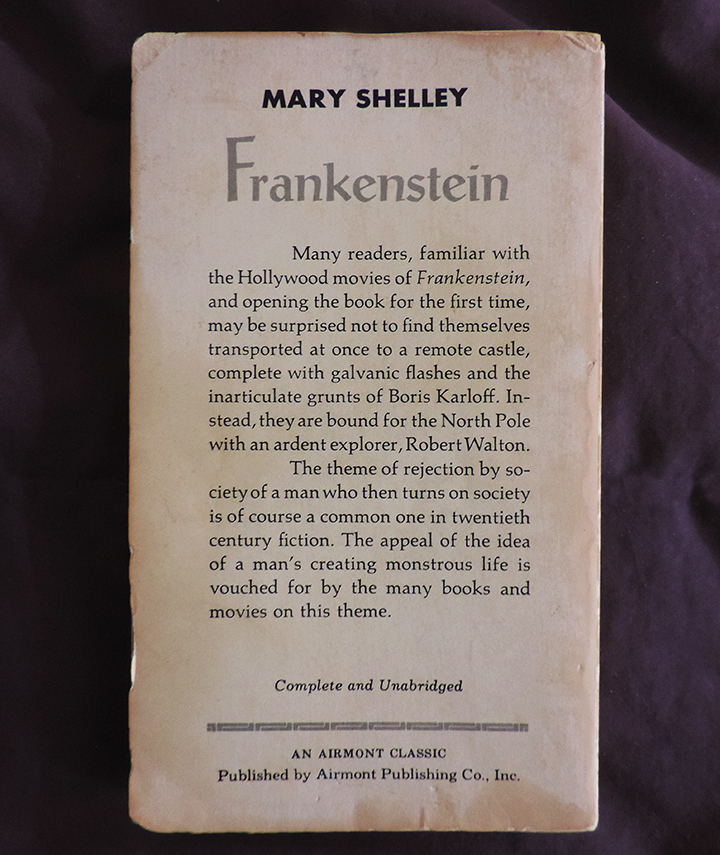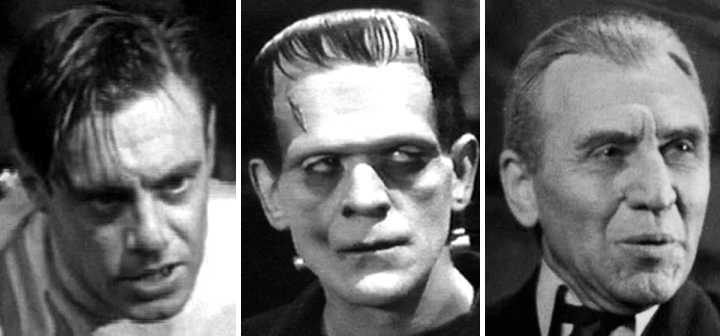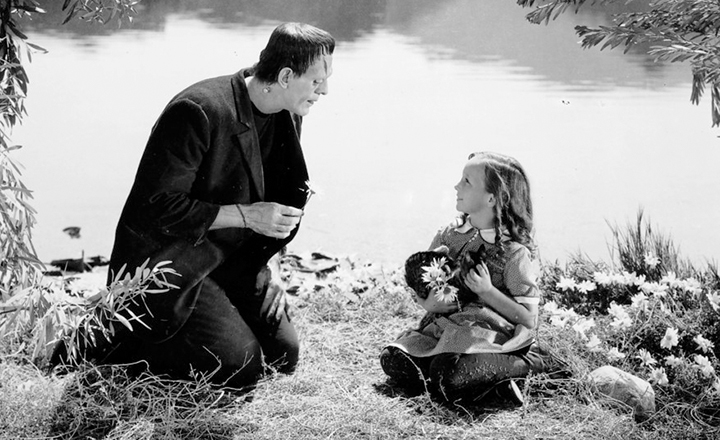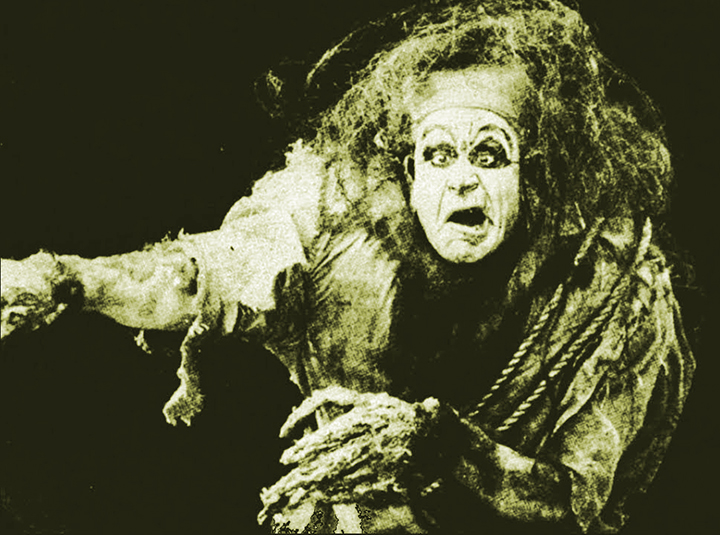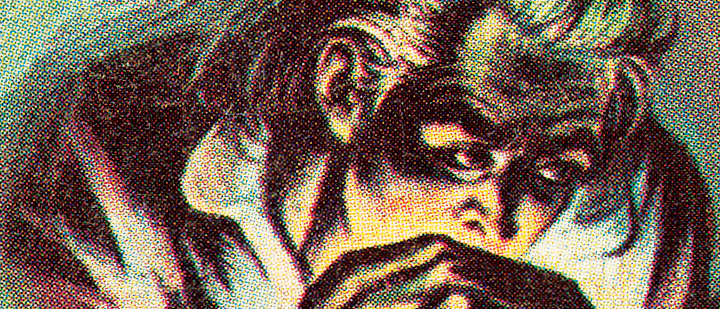
Meet the dæmon
By Mark Voger, author
“Holly Jolly: Celebrating Christmas Past in Pop Culture”
“Frankenstein is the real monster. The creator is the real monster. You understand that, don’t you?”
That’s what my sister, Barbara, told me not long ago. She assumed that her big brother, a Frankenstein fanatic since toddler-hood, had read Mary Shelley’s 1818 novel. (I hadn’t. I merely said that I was finally going to.)
Barbara’s words — “The creator is the real monster” — rang in my head throughout my reading of the book. She is quite correct. Victor Frankenstein created a living being, abandoned it immediately, and then moaned every time his creation spilled blood. What did he think was going to happen?
I believe the following quote from the being encapsulates the book: “When I looked around, I saw and heard of none like me. Was I then a monster, a blot upon the earth, from which all men fled, and whom all men disowned?”
But before I go into the book, which I just finished reading for the first time in my life (at age 63, no less), I’d like to talk about how I was introduced to it.
Book fair
You weren’t permitted to bring monster media into the hallowed halls of Holy Rosary School in the Diocese of Camden, New Jersey, in the 1960s. If spotted by a nun, a copy of, say, Famous Monsters of Filmland would be confiscated and discarded. You’d never see it again.
So what a shock it was when a book fair was held in Holy Rosary’s modest library, and there on the tables for sale, among the Hardy Boys, Nancy Drew and the Boxcar Children, were Shelley’s “Frankenstein,” Bram Stoker‘s “Dracula,” Robert Louis Stevenson‘s “Dr. Jekyll and Mr. Hyde” and H.G. Wells‘ “The Invisible Man.” (I remember wondering where the Wolf Man and Mummy novels were.)
These franchises that I only knew through toys, model kits, movies and magazines began as classic literature, it soon dawned on me, and as such, were apparently immune from interception by nuns. A loophole!
Each year, my parents allowed me to buy one book, so by the fourth grade, I had a nice little collection. I sincerely resolved to read “Frankenstein” and “Dracula,” and earnestly began both. But, thrown by their archaic narrative styles, I soon abandoned them.
A promise is a promise, however, and now, in my dotage, I’ve finally read — and thoroughly enjoyed — both landmark novels. (See my appraisal of “Dracula” HERE.) Following are my thoughts on “Frankenstein.” I read the 1963 paperback edition published by Airmont Publishing Company, Inc., then at 22 East 60th Street in New York, New York — the same one I bought at Holy Rosary’s book fair.
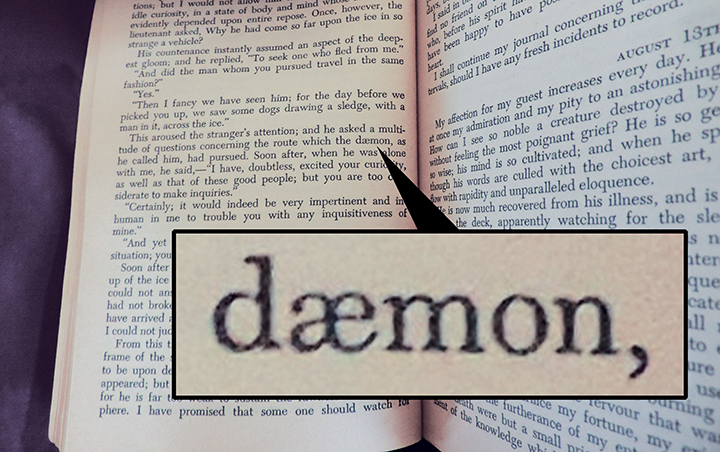
Witnessing history
It’s been a thrill to read a book that is certainly one of the earliest examples of monster media — not a harbinger, like a cave drawing or a Bible passage, but a true, bona fide, actual, real, indisputable instance of monster media. In this way, you could lump “Frankenstein,” the novel, in with Franken Berry, the cereal. That is, if you’re a hillbilly like me.
For anyone who has not only lived under a rock but been flattened by it, “Frankenstein” is the story of a man who plays God and creates another man, but pays dearly for his reckless impertinence. Shelley’s book is more philosophical in tone than horrific, her monster more of an articulate, noble being than a brute (though he does brutal things). Surprise, fellow not-well-read horror geeks!
I felt a distinct thrill, like I was a witness to history, when I read about the first sighting of the monster in the book, a fleeting glimpse of someone or something riding a dogsled, described as “a being which had the shape of a man, but apparently of gigantic stature.” I thought: This is where it all began.
Victor Frankenstein, the sickly man rescued by an explorer, calls that being a “dæmon,” a term he uses repeatedly throughout the story.
Shelley (1797-1851) was 19 when she finished writing “Frankenstein.” Her writing style is not as modern as that of Stoker, but I soon grew accustomed to her language, which sometimes seemed like poetry to my untrained ears. This, I imagine, can be attributed to the offstage influence, via osmosis if nothing else, of her husband, the poet Percy Bysshe Shelley.

The creation
I was surprised at how few practical details Shelley employs in describing the creation of the monster. (Even calling him a “monster” seems counter to Shelley’s intentions, but the word is used several times, including by the being himself.) Growing up, I was always told (by people like Colin Clive and Forry Ackerman) that the being was fashioned from parts of dead bodies sewn together and brought to life via an unholy amalgam of electricity and alchemy. No such descriptions appear in Shelley’s book. We’re left to wonder about, and even invent, how Frankenstein did what he did. The “labours” and “accomplishment” straddle chapters 4 and 5, from which I will quote (with ellipses denoting skipped sentences).
As chapter 4 ends: “Winter, spring, and summer passed away during my labours … I shunned my fellow creatures as if I had been guilty of a crime. Sometimes I grew alarmed at the wreck I perceived that I had become; the energy of my purpose alone sustained me: my labours would soon end, and I believed that exercise and amusement would then drive away incipient disease; and I promised myself both of these when my creation should be complete.”
As chapter 5 begins: “It was on a dreary night of November that I beheld the accomplishment of my toils. With an anxiety that almost amounted to agony, I collected the instruments of life around me, that I might infuse a spark of being into the lifeless thing that lay at my feet. It was already one in the morning; the rain pattered dismally against the panes, and my candle was nearly burnt out, when, by the glimmer of the half-extinguished light, I saw the dull yellow eye of the creature open; it breathed hard, and a convulsive motion agitated its limbs.”
Here, Colin Clive might have yelled “It’s alive!” But honestly, do you have any idea what, exactly, Frankenstein did?
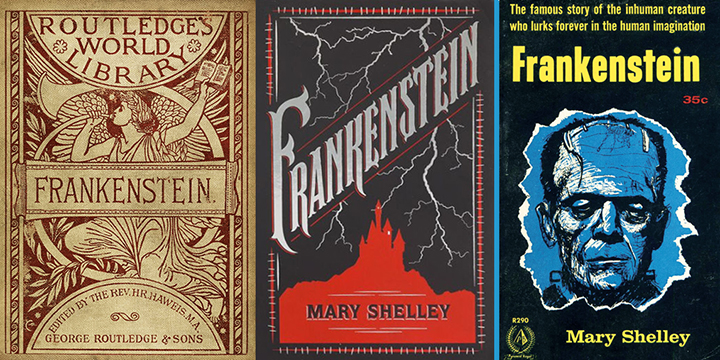
Framing device
The story is told in the epistological format — what am I, an English professor? — which presents a problem. My view has always been that a flashback within a flashback is just wrong. (Try a new approach rather than risk confusing your reader.) “Frankenstein” commits this sin and then some.
Shelley’s framing device is a series of letters from explorer Capt. Robert Walton, an adventurer who pushes his luck in remote regions of the world, to his sister Mrs. Saville, who is safely ensconced in England. During one of his expeditions, Walton rescues a stranger named Victor Frankenstein, who is initially guarded about sharing his backstory, but later spills the beans to Walton in a case of misplaced trust. (Walton, after all, indiscreetly transcribes Victor’s tale of woe for the reading pleasure of his sister.)
Within Victor’s telling, he quotes the monster as he recounts his own tale of woe. (I use the word “quotes” loosely. Both narratives — Victor’s and the monster’s — go on for many chapters each.) For those keeping score, that’s three levels of story-within-a-story: Walton quoting Victor quoting the being. Make it four when the being recounts the history of the cottage-dwelling family he secretly observes (and from whom he learns speech). You can even make it five, considering that we, in the real world, are reading Mrs. Saville’s letters over her shoulder. I tell you, it’s a friggin’ set of Russian nesting dolls!
Get a room
Walton seems to develop a man-crush on Victor, who he calls a “divine wanderer.” Walton writes: “My affection for my guest increases every day” … “his full-toned voice swells in my ears; his lustrous eyes dwell on me with all their melancholy sweetness.” I picture Mrs. Saville reading these words and thinking: I always knew.
It was also a thrill just to read character names from the 1931 movie, such as Elizabeth (Victor’s adoptive cousin and wife) and Waldman (a professor at Ingolstadt, a character greatly expanded in the 1931 film adaptation). Since childhood, I’ve always read that Universal Pictures changed Frankenstein’s first name from Victor to Henry. Now I’ve seen the proof with my own peepers. And I suspect that somewhere between 1818 and 1931, Victor’s best friend, Henry Clerval, had some effect on the name change.
The killing of Victor’s little brother William, and the hanging of the Frankensteins’ servant Justine for same, are very dark, dramatic events. “She perished on the scaffold as a murderess!” cried Victor of Justine’s execution (while knowing full well his role in the dual tragedies). I realize that differences between the 1818 novel and the 1931 film have much to do with the evolution of “Frankenstein” stage productions in the interim. But at heart, I can’t imagine why the powerful William/Justine storyline didn’t survive.
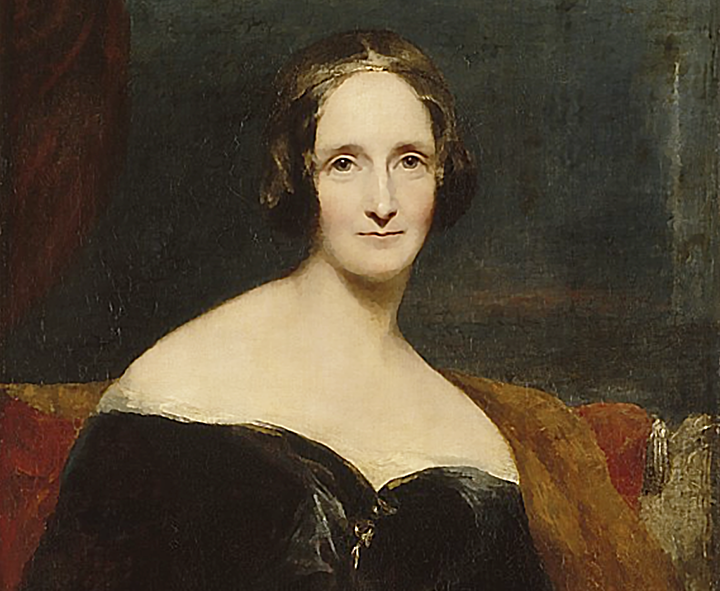
The author speaks
In the 1963 paperback that I (finally) read, Airmont included Shelly’s introduction to the 1831 edition of “Frankenstein.” It is is very telling. Shelley wrote that the question most frequently put to her was “how I, then a young girl, came to think of, and dilate upon, so very hideous an idea.”
She also alluded to the influence of her famous inner circle on “Frankenstein”: “Many and long were the conversations between Lord Byron and Shelley, to which I was a devout but nearly silent listener. During one of these, various philosophical doctrines were discussed, and among others the nature of the principles of life, and whether there was any probability of its ever being discovered and communicated.”
Some musings in Shelley’s 1831 introduction hinted at the creation sequence I’d envisioned as a child. She wrote: “Perhaps a corpse would be re-animated; galvanism had given token of such things: perhaps the component parts of a creature might be manufactured, brought together, and endured with vital warmth.”
P.S.: What’s in a name?
I’ll end my discussion with a digression, something we Irish are geniuses at. I suggest you skip the next two paragraphs, though I had to write ’em just the same.
I’ve always called them “Shelley purists” — people who insist that the name Frankenstein can only refer to the creator, and that we should use the phrase “the Frankenstein monster” to denote the created. Well, that’s a mouthful. And that book came out 202 years ago. And monster nerds are quite accustomed to seeing “Frankenstein” on a model-kit box, but the model inside is of the monster, not his creator. And the creator is nowhere to be found in “Frankenstein Meets the Wolf Man” or “House of Frankenstein” or “Abbott and Costello Meet Frankenstein.” But the monster is.
That said, when discussing Shelley’s book, I agree that the Shelley purists’ policy should be respected. I don’t consider this an about-face. It’s all about context. And like my sister said, “The creator is the real monster.”
Above is Airmont’s moody, monsterific cover for the 1963 edition. As is the case with Airmont’s edition of “Dracula,” the “Frankenstein” cover art is unsigned and uncredited. Anyone knowing the name of either artist is asked to tweet it. (That’s how information is desseminated now, right?)
Airmont’s back cover has an excerpt from Mary M. Threapleton‘s foreword. Who was Mary M. Threapleton? She wrote introductions to Airmont’s editions of “Jane Eyre,” “Wuthering Heights,” “Great Expectations,” “Vanity Fair” and “Frankenstein.” So … she was an introduction writer.
‘Frankenstein’ (novel) vs. ‘Frankenstein’ (film)
Actors in the 1931 adaptation as characters from Shelley’s novel, from left: Colin Clive as Henry (renamed from Victor) Frankenstein; Boris Karloff as the dæmon; Edward Van Sloan as Frankenstein’ old college professor, Dr. Waldman.
More actors in the 1931 adaptation as characters from Shelley’s novel were Mae Clarke as Elizabeth (left) and Frederick Kerr as Frankenstein’s father (center). It’s interesting to note that in both novel and film, Frankenstein’s father suspects another woman is to blame for Victor’s long absences. At right is O.P. Heggie as the blind hermit in the sequel “Bride of Frankenstein” (1935), a character unquestionably based on the blind Parisian De Lacey in the Shelley.
In both the novel and the movie sequel “Bride of Frankenstein,” the monster has a hopeful encounter with a blind man (who cannot see his deformities) which is rudely interrupted by outsiders. In the book, it’s De Lacey’s family; in the movie, it’s a pair of hunters (one played by then-unknown John Carradine).
Another digression: In the year 1980, I saw Carradine play the blind man in the Broadway production of “Frankenstein.” I even met the actor in the alley and spoke with him for a split-second. I’ll write about it some day. Or maybe I just did.
It would be stretching a point to state that Marilyn Harris as Little Maria, the girl who befriends the monster, represents Victor Frankenstein’s little brother William. But there are echoes of William in this sequence. Both William and Maria are unaccompanied, defenseless children who meet the monster by chance in outdoor settings and are killed by him. Directly or indirectly, both deaths lead to Frankenstein hunting his creation with the intention to destroy him.
Can’t do this post right without a shoutout to the very first (albeit, not altogether faithful) film adaptation of “Frankenstein” (1910), a silent short produced by Thomas Edison and starring Charles Ogle as the monster. When I was a child, this film was still “lost,” but the above photo existed. I remember marveling at the withered hand.
VIDEOS
Above is a restored version of Edison’s 13-minute adaptation.
Above is the sequence that introduces Karloff as the monster in the 1931 film adaptation — Horror Movie History itself!

